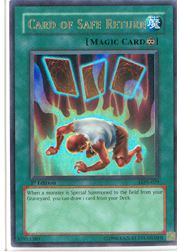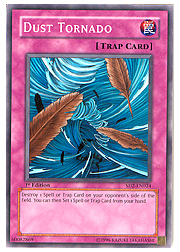With all the recent changes in the card pool and the flurry of archetypes moving through the format, sometimes a great deck gets lost in the mix. Almost every deck that makes the Top 16 did so because it was a strong strategy that had many desirable matchups seeing high amounts of play. Zombies and burn stood true to this: both were very powerful and had very few bad matchups.
When an offbeat deck comes in and outperforms most of the competition, the deck almost always had favorable matchups in that tournament. Machines from last format are a prime example of this, and Warrior decks like the one played by Donald Myers almost always take this path to the Top 16. Playing against the strengths of the current metagame is what propels rogue decks to the top.
Jerome Baisey exploited the same philosophy with this masterpiece at Shonen Jump Championship Washington:
Monsters: 18
3 Cyber Dragon
3 Mystic Tomato
2 Don Zaloog
1 Spirit Reaper
2 D. D. Assailant
2 Exiled Force
1 Asura Priest
1 Neo-Spacian Grand Mole
1 Sangan
1 D.D. Warrior Lady
1 Breaker the Magical Warrior
Spells: 14
1 Heavy Storm
1 Mystical Space Typhoon
1 Premature Burial
1 Pot of Avarice
2 Reinforcement of the Army
1 Smashing Ground
1 Fissure
2 Nobleman of Crossout
1 Scapegoat
1 Shrink
2 Creature Swap
Traps: 8
1 Mirror Force
1 Torrential Tribute
1 Call of the Haunted
2 Sakuretsu Armor
1 Bottomless Trap Hole
2 Dust Tornado
 This kind of deck is one of my personal favorites. It enters the game with one plan: reduce the opponent’s life points to zero any way it can. While this may sound like every player’s strategy, most decks go into the match with a more constricted overall game plan. Zombies want to storm the field and back up their assets with Card of Safe Return. Burn decks will try to lock down the game state before winning with a Wave-Motion Cannon.
This kind of deck is one of my personal favorites. It enters the game with one plan: reduce the opponent’s life points to zero any way it can. While this may sound like every player’s strategy, most decks go into the match with a more constricted overall game plan. Zombies want to storm the field and back up their assets with Card of Safe Return. Burn decks will try to lock down the game state before winning with a Wave-Motion Cannon.
The actions this deck takes depend entirely on what the opponent is playing and how he or she chooses to play it. The build is extremely flexible, and can cope with offensive or defensive plays from almost every strategy it’s likely to encounter. The Warrior Toolbox engine providing the backbone of the deck sees to that. One thing this strategy does plan on before the game is using Reinforcement of the Army to solve its problems. Being able to fish out four different Warriors that serve four different purposes means that Jerome can be ready for almost anything.
Exiled Force is the simplest of the four options. At the low cost of your normal summon for the turn, it can destroy any monster on the field, regardless of position or ATK power. Even Skill Drain or Book of Moon can’t prevent this monster from using its ignition effect, and that’s what makes the card so good. Peace of mind is hard to come by in the Yu-Gi-Oh! TCG, but when you have it, the game becomes a lot easier. Exiled Force gives you that guaranteed removal, which means you won’t have to worry about a flip effect or a recruiter breaking the game open if you attack it.
D. D. Assailant and D.D. Warrior Lady are the next two Warriors on the list. The Assailant can remove any monster that destroys him in battle, and the Warrior Lady can remove any monster she battles with. With reasonable ATK values and 1600 DEF, the duo can put quite a bit of hurt on an opponent who can’t defend against them. Considering the low number of defensive traps and Jerome’s high quantities of attacking monsters, this doesn’t seem entirely unreasonable.
Don Zaloog is the final Warrior Jerome can search for, and the one he probably looks for the most. The ability to disrupt your opponent’s plans by discarding a card from his or her hand cannot be underestimated, especially in a combo-intensive format like this one. With 1400 ATK and 1500 DEF, Don Zaloog is one of Jerome’s best weapons for fighting recruiters and smaller monsters that have already earned a piece of card presence. Monsters from the latter group usually have low ATK points and are willing to attack whenever they get the chance. This means the Don can usually destroy one in battle. Furthermore, Jerome could probably get away with setting his Don Zaloog in defense mode the turn before. His opponent will feel the pain once he or she swings a Sangan into the face-down Zaloog, only to have him destroy Sangan next turn and take a second card from the opponent’s hand.
But that’s not all the deck does. To support the attack-and-defend policy required of monsters in this deck, Jerome plays three copies of Mystic Tomato and the lone allowed copies of Spirit Reaper and Neo-Spacian Grand Mole. Each of these monsters can freely attack directly, and each can defend very well. Tomato can also combo up with Creature Swap and Shrink, and can search for the most valuable Dark monster with 1500 ATK or less for any situation.
Spirit Reaper adds more discarding trouble for the opponent, and when you consider that Jerome has a healthy amount of monster removal in his deck, the odds of Reaper or Don getting through become scarily good. In addition, Spirit Reaper can’t be used as a tribute via Soul Exchange, so Light and Darkness Dragon decks will have some trouble taking it down.
The Grand Mole is a funky little monster, capable of locking down the opponent entirely if he or she suffers from a defenseless draw. When used in conjunction with Cyber Dragon, the Grand Mole can inflict multiple 2100 life point hits, even if the opponent has reliable defensive monsters. Grand Mole can also combo with Creature Swap, further adding to the arsenal of tricks at this deck’s disposal.
 The remainder of the deck is really just a pile of versatile cards. Monster removal and commonly played cards make up the core of the spell and trap line-ups, and useful material like Dust Tornado and Creature Swap fill the gaps. Dust Tornado is especially useful for a deck like this that can produce random combos of game-changing cards. Creature Swap, Don Zaloog, and friends can all turn the tide of a game instantly if there is no defense to stop them. Dust Tornado clears the path. However, in a format filled with burn decks and Card of Safe Return, being able to destroy optimal spell or trap cards can win duels . . . making Dust Tornado one of your best cards.
The remainder of the deck is really just a pile of versatile cards. Monster removal and commonly played cards make up the core of the spell and trap line-ups, and useful material like Dust Tornado and Creature Swap fill the gaps. Dust Tornado is especially useful for a deck like this that can produce random combos of game-changing cards. Creature Swap, Don Zaloog, and friends can all turn the tide of a game instantly if there is no defense to stop them. Dust Tornado clears the path. However, in a format filled with burn decks and Card of Safe Return, being able to destroy optimal spell or trap cards can win duels . . . making Dust Tornado one of your best cards.
One thing I really like about this deck is that it plays only one copy of Shrink. Although many monsters work well with the card, using only one copy means the opponent can’t predict when it will be played. Most players can work around Shrink if it’s the only method of defense, but with only one copy in his deck, Jerome can easily punish players who think they’re outsmarting him. On the flip side, playing as if Shrink isn’t a problem can mean a completely devastating turn when Jerome chooses to play it.
Many players will come to appreciate versatility as the format progresses. I wouldn’t be surprised to see more decks like Jerome’s in the future: awkward to look at and annoying to face.